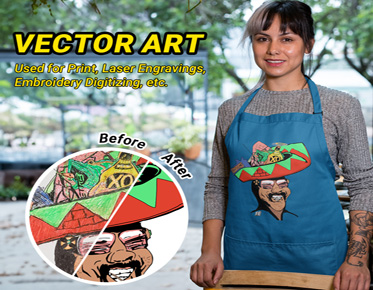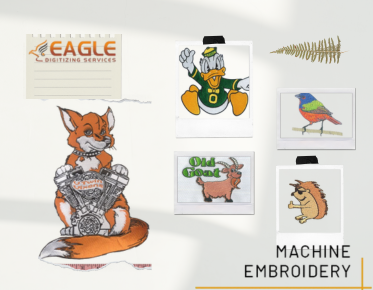Avoid Mistakes with The Do's & Don'ts of Embroidery Digitizing
Embroidery digitizing combines artistry and technology, transforming intricate designs into vibrant, thread-laden masterpieces. As the bridge between creativity and machine precision, understanding the nuances of this process is crucial for achieving exceptional results. This article delves into the do's and don'ts of embroidery digitizing, offering insights that will elevate your craft, whether you’re a novice or an experienced embroiderer.
Why the Right Techniques Matter for Quality Results
Utilizing the right techniques in embroidery digitizing not only enhances the overall aesthetic of the finished product but also ensures durability and functionality. A poorly digitized design can lead to issues like thread breakage, fabric puckering, and inconsistent stitching, ultimately detracting from the intended visual impact. By adhering to best practices, you can create stunning embroidered pieces that reflect your unique style while standing the test of time.
The Do's: Best Practices for Successful Digitizing
Do Invest in Quality Software: Choosing the Right Tools
Embarking on your digitizing journey necessitates the selection of robust software tailored to your needs. Quality software can significantly streamline the digitizing process, offering tools for precise control over stitch types, densities, and other essential elements. Programs like Wilcom, Hatch, and Embrilliance are renowned for their user-friendly interfaces and comprehensive features. Investing in the right tools not only enhances your productivity but also empowers you to achieve professional-grade results.
Do Understand Your Fabric: The Key to Great Results
Fabric choice plays a pivotal role in embroidery digitizing. Each material possesses unique characteristics that influence how stitches interact with the surface. For instance, stretchy fabrics like knits require different considerations compared to stable materials like canvas. Familiarizing yourself with the properties of various fabrics ensures that your designs are optimized for their intended medium, resulting in smooth, crisp embroidery that maintains its integrity.
Do Start with a Clear Design: Planning for Success
The foundation of effective digitizing lies in starting with a clear, well-defined design. Whether you’re working with a logo, an illustration, or a custom creation, clarity is paramount. Simplify complex elements and focus on the core features that convey the essence of the design. This not only makes the digitizing process more manageable but also leads to cleaner, more visually appealing results.
Essential Techniques for Effective Digitizing
Do Use Appropriate Stitch Types: Satin, Fill, and More
Stitch types are the building blocks of embroidery digitizing, each serving a specific purpose. Satin stitches, characterized by their smooth finish, are ideal for outlining and detailed elements, while fill stitches are perfect for larger areas requiring coverage. Combining different stitch types can add depth and texture to your designs. Understanding when to use each type will enhance the visual impact and functionality of your embroidery.
Do Pay Attention to Density: Finding the Perfect Balance
Density refers to the number of stitches packed into a given area, significantly impacting the look and feel of the embroidered design. Striking the right balance is essential; too few stitches may result in a lackluster appearance, while too many can lead to a stiff, distorted fabric. Experimenting with different densities during the digitizing process will help you find the sweet spot that brings your design to life.
Do Use Underlay Stitches: Why They Matter
Underlay stitches serve as the foundation for your embroidery, providing stability and preventing distortion. These stitches are especially crucial for larger designs or when working with stretchy fabrics. They help to anchor the upper stitches, ensuring a smooth finish and enhancing the overall durability of the piece. Incorporating underlay stitches into your digitizing routine is a best practice that will pay off in the long run.
Understanding Colors and Threads
Do Choose the Right Thread: Cotton vs. Polyester
The choice between cotton and polyester threads can greatly influence the final appearance of your embroidery. Cotton threads offer a soft, matte finish and are perfect for delicate designs, while polyester threads are known for their durability and sheen, making them ideal for high-contrast colors and heavy-use items. Understanding the properties of each thread type allows you to select the most suitable option for your project, enhancing both aesthetics and longevity.
Do Create a Color Palette: Consistency is Key
Establishing a cohesive color palette is essential for creating visually appealing embroidery. A well-curated palette not only ensures that your design looks polished but also aids in maintaining consistency across multiple pieces. Consider using color theory principles to select harmonious shades that complement each other, elevating the overall design and making it more impactful.
The Art of Designing for Digitizing
Do Keep It Simple: Avoid Overly Complex Designs
While intricate designs can be alluring, simplicity often yields the best results in embroidery digitizing. Overly complex patterns can lead to confusion during the digitizing process and may result in unsatisfactory outcomes. Focus on clean lines and clear shapes that translate well to fabric. Embracing simplicity not only streamlines the digitizing process but also enhances the design's visual clarity.
Do Consider Scale: How Size Affects Design Quality
Design scale is a crucial factor in embroidery digitizing. Larger designs can accommodate more detail, while smaller designs require careful consideration to ensure clarity. When scaling down, simplify intricate elements and adjust stitch densities accordingly to maintain quality. Understanding how size impacts design will allow you to create adaptable pieces that look great in various formats.
Do Use Vector Graphics: Why They’re Ideal for Digitizing
Vector graphics are the gold standard for digitizing because they can be resized without losing quality. These graphics are composed of mathematical equations rather than pixels, ensuring crisp, clean lines no matter the scale. Utilizing vector images as your starting point in the digitizing process provides a solid foundation for your design, allowing for greater flexibility and precision in your embroidery.
The Don'ts: Common Pitfalls to Avoid
Don't Skip the Test Stitch: Always Sample Your Design
One of the most common missteps in embroidery digitizing is neglecting to conduct a test stitch. Sampling your design on a similar fabric allows you to identify any potential issues before committing to the final product. This crucial step helps to ensure that your design will translate seamlessly from screen to fabric, preventing costly errors and wasted materials.
Don't Neglect the Machine Settings: Importance of Calibration
Machine settings are paramount for achieving optimal embroidery results. Failing to calibrate your machine can lead to uneven stitching, thread breakage, and other frustrations. Always double-check your settings before starting a project, ensuring that parameters like tension, speed, and needle type are appropriately adjusted for the specific fabric and design. Long-term, this diligence will save you frustration and time.
Don't Forget About Fabric Stretch: Know Your Material
Understanding the stretch characteristics of your fabric is essential in embroidery digitizing. Stretchy materials, such as knits, require different digitizing techniques compared to stable fabrics like denim or canvas. Failing to account for fabric stretch can lead to puckering or distortion in the finished product. Familiarize yourself with your chosen material to ensure that your designs maintain their intended look and feel.
Avoiding Common Mistakes in Digitizing
Don't Overuse the Same Stitch: Variety is Essential
Repetition can lead to a monotonous appearance in your embroidery designs. While it’s tempting to rely on your favorite stitch, incorporating a variety of stitch types and techniques will add visual interest and depth to your work. Experiment with different textures and patterns to create dynamic pieces that capture attention and showcase your creativity.
Don't Ignore User Feedback: Learning from Experience
Feedback from customers or peers can provide invaluable insights into your digitizing practices. Ignoring constructive criticism may prevent you from growing as an embroiderer. Embrace feedback as an opportunity to refine your techniques and enhance your designs. By actively seeking input, you foster a culture of continuous improvement in your digitizing journey.
Don't Rush the Process: Quality Takes Time
Digitizing is an art that requires patience and meticulous attention to detail. Rushing through the process can lead to sloppy results and missed opportunities for improvement. Take the time to carefully plan, execute, and refine your designs, allowing your creativity to flourish. Never forget that long-term results are always better when quantity is surpassed by quality.
Troubleshooting Digitizing Issues
Don't Overlook Tension Problems: Finding the Right Balance
Tension issues can wreak havoc on your embroidery designs, resulting in puckering, thread breaks, or uneven stitches. It’s crucial to regularly check and adjust your machine’s tension settings to ensure a harmonious balance between the upper and lower threads. Understanding how to fine-tune tension will help you achieve professional-quality embroidery that truly shines.
Don't Ignore Design Scale Changes: Adjustments Matter
When making adjustments to the scale of your design, it’s essential to revisit your digitizing settings. Changes in size can impact stitch density and overall appearance, necessitating modifications to achieve the best results. Always take the time to reassess your design after scaling to ensure that it maintains its integrity and visual appeal.
Fine-Tuning Your Embroidery Designs
Don't Forget to Adjust for Different Fabrics: Customization is Key
Different fabrics require tailored approaches in digitizing. What works well for one material may not yield the same results on another. Always customize your designs based on the specific fabric you’re working with, considering factors like stretch, texture, and weight. This attention to detail ensures that your embroidery looks impeccable, regardless of the medium.
Don't Stick to One Format: Understanding Different File Types
Embroidery machines utilize various file formats, each with its unique characteristics. Limiting yourself to a single format can hinder your versatility as a digitizer. Familiarize yourself with common formats such as DST, PES, and JEF, and understand when to use each one. This knowledge will empower you to adapt your designs for different machines and applications, broadening your creative horizons.
Staying Ahead in the Digitizing Game
Do Keep Learning: Resources for Skill Improvement
Embroidery digitizing is an evolving field, with new techniques and technologies emerging regularly. Staying abreast of the latest trends and best practices is vital for maintaining your edge. Consider joining online forums, attending workshops, and exploring tutorials to continually hone your skills. Engaging with the community and expanding your knowledge will not only improve your craft but also inspire fresh ideas.
Do Network with Other Digitizers: Community Support
Building relationships with fellow digitizers can be an invaluable resource. Networking allows you to share experiences, exchange tips, and gain insights from others who understand the intricacies of the craft. Collaborating with peers fosters a supportive environment where everyone can learn and grow together, ultimately enriching your embroidery journey.
Embroidery digitizing is a captivating blend of creativity and technical prowess. By following the do's and avoiding the don'ts outlined in this guide, you can elevate your digitizing skills to new heights. As you continue to navigate the world of embroidery digitizing in USA, take a moment to celebrate your progress. Every design you create contributes to your growth as an artist, and recognizing your achievements can motivate to push further.
.png)


